|
SpaceTides e-zine
#44 – 8 June 2006
Internet
Newsletter of ASSA Bloemfontein Centre, South
Africa, to the public
www.assabfn.co.za/spacetides

|
_________________________________________________________________________________________
Subscribe to the free SpaceTides e-zine by
sending an e-mail to spacetides@assabfn.co.za
with the word "Subscribe" in the subject line if you are not
already subscribed. |
In this issue of SpaceTides |
INDEX
Feedback form - your comments welcome!
Importance of Astronomy write-up on website
1. Spaceflight news from
around the world
2. Astronomy news from around the world
3. Interesting space facts
4. Space Questions
5. Sky Observation log
6. Amateur Astronomers' Corner
7. Astronomy & Science in Southern Africa
8. Photo Sense
9. Web links
Dear
SpaceTides subscribers
Please see the
"Feedback form" information below. Your comments about the
SpaceTides e-zine will be much appreciated! Filling in the form will only
take a minute or two. Access it at www.assabfn.co.za/spacetides/feedback.htm or ask us to send you one if you don't have internet access.
Enjoy this issue of SpaceTides,
Gerrit Penning
Editor
Total subscribers as at 8 June 2006: 528 (+20 from previous
issue #43) |

|
Feedback
Form on website for subscribers
You are invited
to air your opinion on SpaceTides. Your comments and suggestions are welcome.
The form is anonymous and should help to futher improve the quality of the
SpaceTides e-zine. Please visit www.assabfn.co.za/spacetides/feedback.htm. |

|
Importance
of Astronomy write-up on website
If someone ask you why we
spend so much money on scientific/astronomical research, you might want to
use some of the points given in this write-up. I promised it awhile ago in
one of the previous issues.
You can access the write-up at www.assabfn.co.za/spacetides/issues/importance.htm |
____________________________________________________________________________________________
1. Spaceflight news from around the world |

The
SOHO
spacecraft, artist's rendition. Credit: ESA |
SOHO
set to work until 2009
Information partly obtained
from an ESA News
Release, 24 May 2006
The Solar and Heliospheric Observatory (SOHO) was
launched on 2 December 1995 and has provided scientists and unprecedented
view of our closest star, the Sun. New funding will allow
SOHO
's
mission to be extended to December 2009.
Even though
SOHO
is over ten years old, it is still beaming back
very important data relating to the Sun. It monitors the Sun's activity and
even allows scientists to peer into its inner parts through the recording of
seismic waves that ripple across the surface.
During
the next two years, five new solar spacecraft will join
SOHO
and the rest in orbit. A whole fleet of probes will then be monitoring the
Sun. Research is crucial, as scientists are only now beginning to truly
understand the impact that the Sun has on Earth's components like the
magnetosphere, atmosphere, climate, etc. We are fortunate that our Sun is so
stable, but let's not take any risks! |
________________________________________________________________________________________
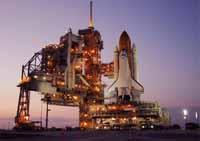
Shuttle Discovery on its
launch pad. Credit: NASA-KSC |
Shuttle Discovery set to launch on 1 July 2006
Information from
obtained from the NASA website,
June 2006.
Space Shuttle Discovery's launch is targeted for July 1. The launch window
extends to July 19. Mission STS-121 as it is called will pay a visit the
International Space Station (ISS) and will also continue evaluating new
shuttle safety improvements.
At least two spacewalks are planned during the 12-day mission, which also
includes repair work to the station. Maintenance to the ISS is
also scheduled to be performed and the shuttle will deliver supplies and
cargo for future station expansion.
Discovery will bring a third crew member to the station, ESA's Astronaut
Thomas Reiter. This will be the first three-person crew since the
Expedition 6 crew returned to Earth on 4 May 2003. |
2. Astronomy news from around the world |

Artist depiction of an asteroid hitting the Earth. (OSU website) |
Planetary scientists have found evidence of a meteor impact much larger and earlier
than the one that killed the dinosaurs 65 million years ago - an impact they
believe might have caused the biggest mass extinction in Earth's history.
The 483 km wide crater lies hidden more than a kilometer beneath the East
Antarctic Ice Sheet. The scientists used gravity fluctuations measured
by NASA's GRACE satellites to peer beneath the surface. The measurements that
reveal its existence suggest that it could date back to about 250 million
years, corresponding to the time of the Permian-Triassic extinction, when
almost all animal life on Earth died out.
The evidence also suggests that the impact could have begun the breakup of
the Gondwana supercontinent by creating the tectonic rift that pushed
Australia
northward. Scientists believe that the Permian-Triassic extinction paved the
way for the dinosaurs to rise to prominence.
|
________________________________________________________________________________________
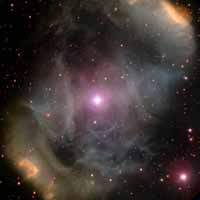
NGC 6164-5 imaged at Gemini South. Image
credit: Gemini. |
A
View of NGC 6164-5
Information
obtained from a Gemini
Observatory News Release dated 5 June 2006
This image shows the emission nebula NGC 6164-5. It lies about 4,200
light-years away in the constellation Norma. The nebula measures about 4.2
light-years across, and contains gases ejected by the star HD 148937 at its
heart. This star is 40 times more massive than the Sun, and although it is
only about three to four million years of age, it is already past the middle
of its life span. The star is aging quickly, as stars this massive
usually live to be only about six million years old. Its end will most likely
take the form of a supernova explosion.
NGC 6164 and 6165 are
visible to amateur astronomers using proper telescopes. NGC 6164-5 is a small
(6’ x 3’) inverted S-shaped nebula. Its appearance in a telescope is
adversely affected by the brightness of its star, 6.8-magnitude HD 148937.
(The dual NGC entry refers to the nebula’s two brightest crescents,
discovered by Sir
John Herschel in 1834 while observing from the Cape of Good Hope in South
Africa). NGC 6164 lies northwest of the central star, while NGC 6165 lies
immediately southeast of it. |
3. Interesting Space Facts |
The
Basic Types of Telescope (refractors and reflectors)
Refracting telescopes: The
refractor uses a lens at the front. Light passes through the lens and is
focused towards the eyepiece at the back. They are much longer compared
to reflectors of similar aperture. Illustration of how a refractor works:

Reflecting
telescopes: Reflectors
usually use a concave mirror at the back to collect and focus the incoming
light back onto a flat secondary (diagonal) mirror. The secondary in turn,
reflects the light out through an opening at the side of the main tube (in
the case of a Newtonian design) or through a hole in the primary mirror (in
the case of a Cassegrain) - and into the eyepiece. There are various types of
reflectors, but only the Newtonian design is illustrated here:

|

M16, the
Eagle Nebula - NASA, ESA, STScI, J. Hester and P. Scowen (
Arizona
State
University
) |
What is the Eagle Nebula?
The Eagle Nebula
is a huge cloud of gas and dust. Amateur astronomers will recognise it as
Messier object 16 - it is 7,000 light years away and is located in the
constellation of Serpens Cauda. It is also a breeding ground for new stars,
which illuminate the gas.
The Hubble Space Telescope has taken pictures of immense hydrogen and dust
"pillars" in the nebula. These pillars are slowly
"evaporating" due to intense radiation from massive stars that were
recently born nearby.
New stars are forming from gas that condenses within these stellar nurseries,
a process that can take about one hundred million years. Source: HubbleSite
FAQ.
Hierdie foto verskyn ook op die voorblad van Gideon Joubert se boek,
"Die Groot Gedagte" - a boek wat ten sterkste aanbeveel word,
alhoewel dit 'n tweede of selfs 'n derde keer (of meer) gelees moet word voor
die moeiliker konsepte verstaanbaar raak! 'n Goeie agtergrond kennis in
basiese sterrekunde voor 'n mens die boek aanpak sal ook help. M16 is
sekerlik een van die mees gepaste foto's wat Gideon vir sy voorblad kon kies. |
Not sure where to start with the night sky? Contact SpaceTides
for assistance!

Photo with 30 seconds exposure, the pointers visible at left and Crux above
centre. An Astronomy Grade green laser pointer was held steady on the
star Alpha Crucis.
|
Planets
visible - June 2006
Mercury is visible after sunset, for the whole month, fading as the
days progress.
Venus is still a morning object, shining with a fierce glow in the
east.
Earth is not too bad. In fact, its conditions are so close to perfect,
that it can even support life! If you happen to live on this very peculiar
little speck in space, try to have respect for it, for the sake of its future
generations please.
Mars is situated in the evening sky in the north-west.
Jupiter (evening) shines bright in the east, moving over the meridian
as the night goes by.
Saturn is close to Mars in the north-west. Don't confuse the two! Mars
has a red colour.
Constellations
and stars
Some of the major late-autumn constellations now visible in the evening sky
include Virgo (its brightest star, Spica, is quite prominent) with its
numerous galaxies, Corvus and Crater close by (the Crow and Cup) and Coma
Berenices to the north with its large and beautiful star cluster visible to
the naked eye. To the south are Centaurus, Crux and Musca.
Deep sky Objects
Here are a few specially selected deep sky objects suitable for observation
during this time of the year. Binoculars: IC 2602, NGC 2516, NGC 3532
(open clusters) and NGC 3372 (nebula) all in Carina. If you still need to
observe objects in Puppis, you only have a few weeks left early evenings! Telescopes: (8 inch & up recommended): NGC 3132 (Eight-burst planetary nebula) in
Vela, NGC 5128 (Centaurus A galaxy), NGC 3766 (open cluster) in Centaurus,
NGC 3293 (open cluster) in Carina. NGC 3242 (Ghost of Jupiter planetary
nebula) and M83 (galaxy) both excellent objects in Hydra.
Other events
Full moon on 11 June 2006. New moon on 25 June 2006.
The Moon occults the star Antares in the early morning hours on
11 June 2006 - see section 6 below for more info. |
6. Amateur Astronomers' Corner |
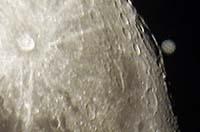
The moon occulting Jupiter, photo by Hannes Pieterse (ASSA Bloemfontein) on
22 April 2005. |
Lunar Occultations
An activity that amateur
astronomers can undertake is the observation of lunar occultations. When the moon
move in front of a star or planet, a total occultation takes place (the star
or planet "disappears" behind the moon). Objects disappear at the
eastern edge of the moon - remember that the moon moves in the opposite
direction to the stars.
Stars disappear instantly while
planets fade behind the moon. As the moon moves through the zodiacal zone, it
sometimes occults bright stars (and naked eye planets). Lunar occultations
for 2006 can be found on page 56 of ASSA's Sky Guide Africa South.
The next major occultation is due
on 11 June 2006 when the moon occults the bright red giant Antares (magnitude
1.1) in Scorpius. For Bloemfonteiners the time of disappearance is at
01:03:59 (69 degr.) and reappearance 02:23:46 (51 degr.). Remember to watch early
morning 11 June and not 12 June! Set your alarm on 10 June before going to
bed. |
7. Astronomy & Science in
Southern
Africa
|
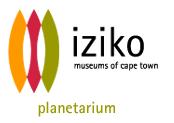
|
Cape Town
Planetarium
The Planetarium is
housed in the
South
African
Museum
building in
Cape Town
and is a "celestial theatre in the round", utilizing a Minolta star
machine and multiple projectors to transport the audience through the wonders
of the universe. The Planetarium's website can be found at http://www.museums.org.za/planetarium/about.html |
__________________________________________________________________________________________
For other SA Astronomy
websites, go to the SpaceTides SA Astronomy Portal at:
www.assabfn.co.za/spacetides/sa_astronomy.htm
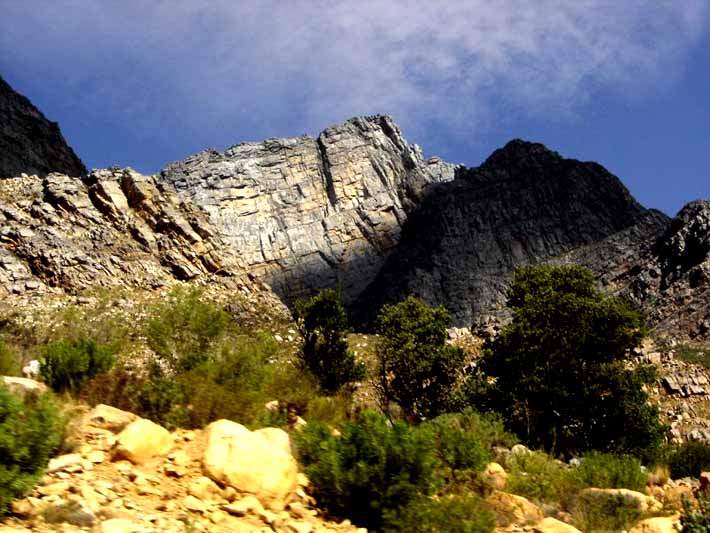
Mountains in the
Hex
River
Valley
in the
Western Cape
,
South Africa
,
towering over the famous wineries in the area. The picture's contrast was increased
to bring out the various and vivid colours. Picture taken (from a moving
car!) by Gerrit Penning on
18 March 2006 with a Sony 5.1 DSC-P93A digital. |
_____________________________________________________________________________________________________________________
SpaceTides is a free internet e-zine for persons
interested in expanding their general knowledge of astronomy and
spaceflight.
The e-zine originates from the City of
Bloemfontein
in
South Africa
and is compiled us a service to the public by ASSA Bloemfontein Centre
as part of their educational outreach activities. Website: www.assabfn.co.za.
SpaceTides contains links to various other third party sites on the
internet, not always connected to SpaceTides. The persons and entities
responsible
for compiling SpaceTides will not be held responsible for the content or
information on these third party sites or any damage of any kind incurred
from
downloading, opening, or viewing anything from/through these sites.
If you would like to unsubscribe from SpaceTides, send an e-mail to spacetides@assabfn.co.za with the word "Unsubscribe" in the subject line.
_____________________________________________________________________________________________________________________________
|



